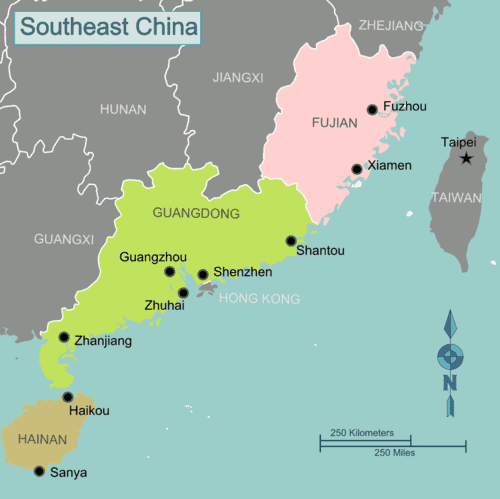Southeast China
Southeast China has always been outward-looking. Many of China's mariners and traders have come from this region and most overseas Chinese can trace their ancestry to the Southeast.
Over a thousand years ago, this area was the main terminus of the Maritime Silk Road, and traded extensively with Japan and Southeast Asia. Today, it is again a major center for trade; Guangdong alone produces a third of China's exports, and the other provinces of the region are also very much open for business. Five of China's six Special Economic Zones — areas with tax breaks and other government measures to encourage trade and development — are in this region.
Regions
| Fujian Province |
| Guangdong Province (Eastern Guangdong, Northern Guangdong, Pearl River Delta, Western Guangdong) |
| Hainan Province |
Two former colonies, Portuguese Macau and British Hong Kong, are now Special Administrative Regions of China. Economically and linguistically, they are very much part of this region, but they are not covered in this article because they are administered quite differently under the slogan "One country, two systems". They have their own entry requirements, visas, and currencies.
In some ways, Taiwan could also be considered part of this region — it has had much immigration from Fujian, Fujian dialects are commonly spoken, and it was once administered as part of that province. However, it is economically and politically distinct with its own visas and currency, so it is also not treated here.
Cities
- Fuzhou, capital of Fujian
- Guangzhou, capital of Guangdong, historically Southern China's greatest city, and the third largest city in China
- Haikou, capital of Hainan
- Quanzhou, historic port, formerly a major terminus for the Maritime Silk Road
- Sanya, Hainan's tourist center
- Shantou, Special Economic Zone, Guangdong
- Shenzhen Guangdong megacity, Special Economic Zone, next to Hong Kong
- Xiamen, Special Economic Zone, Fujian
- Zhanjiang, Guangdong
- Zhuhai, Special Economic Zone, Guangdong, next to Macau
The Special Economic Zones have various government measures to encourage trade and investment. In addition to the cities indicated above, the entire island province of Hainan is such a zone, mainly for tourism-oriented development.
Stay Safe
According to UNAIDS, 0.5% of Chinese sex workers are infected with HIV. One study reported that 5% of low-cost sex workers were infected. In one part of Yunnan province, the infection rate is estimated to be as high as 7%. The Chinese government has initiated programs to educate sex workers in HIV/AIDS prevention.
Rising HIV/AIDS rates among Chinese's elderly has been partially attributed to the use of sex workers.
China is a huge country that shows a huge regional difference in crime rates but in general it poses no more risk than most western countries. Although you may hear locals complaining about increasing crime rates, violent crime remains rare. Many tourists will more likely feel safer in China than in their home country.
|
Healthcare for foreigners Most major Chinese cities have clinics and hospitals that are more appropriate for foreigners, with English speaking and Western qualified staff. Although expensive, it is worth identifying them whenever you plan to stay in an area for a significant time. For non-urgent medical treatment, you may want to consider traveling to Hong Kong, Taiwan or South Korea for a higher standard of treatment which may not be particularly more expensive. |
Emergency numbers
The following emergency telephone numbers work in all areas of China; calling them from a cell phone is free.
- Patrol Police: 110
- Fire Department: 119
- (Government-owned) Ambulance/EMS: 120
- (some areas private-owned) Ambulance: 999
- Traffic Police: 122
- Directory inquiries: 114
- Consumer Protection: 12315

